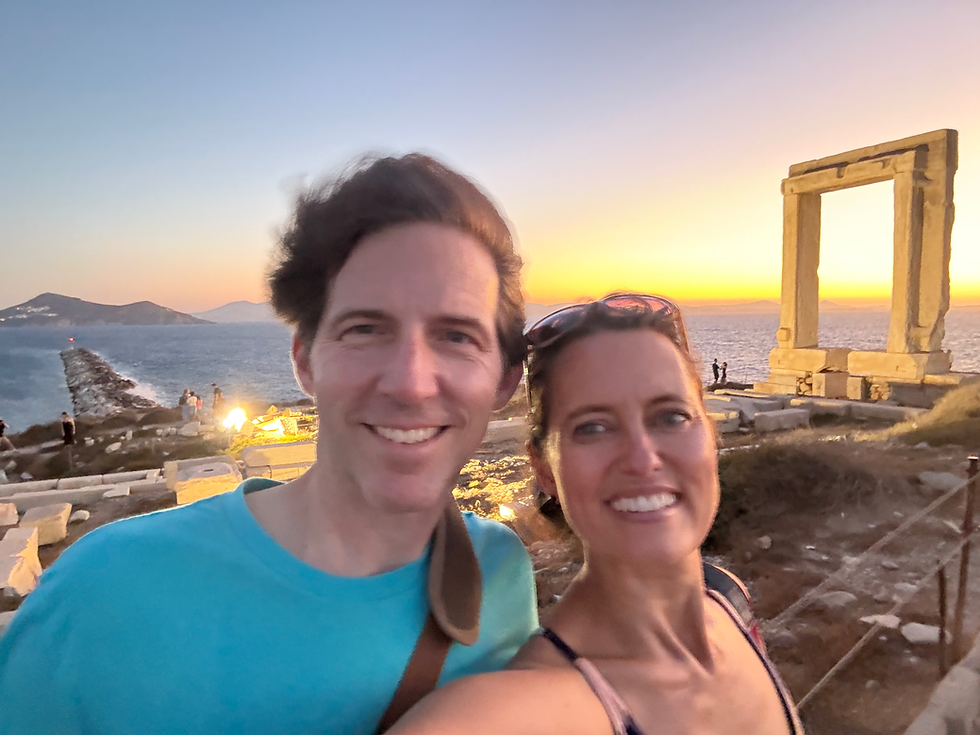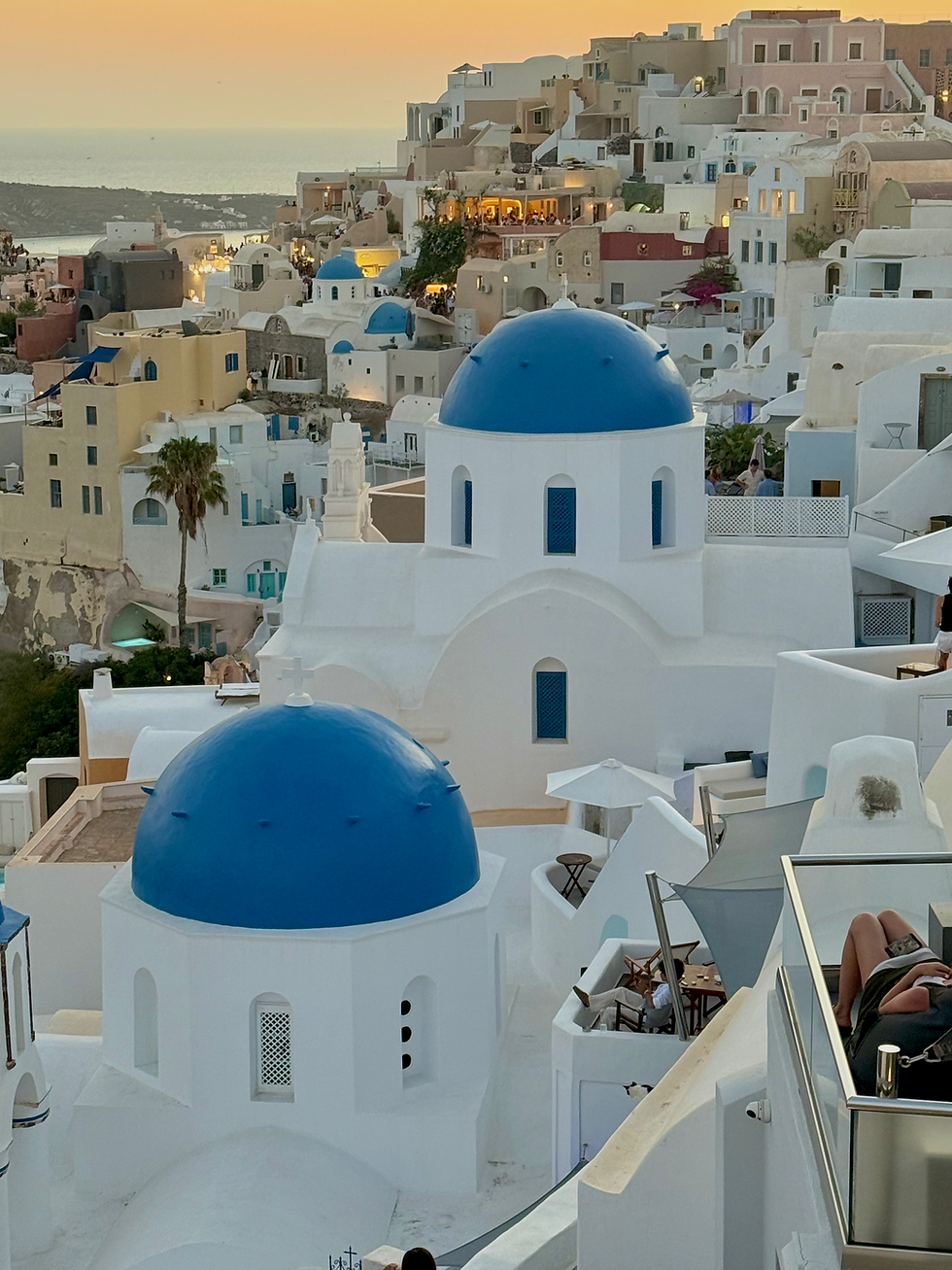Naxos - Gateway to the Islands
- Amy Digges
- Jul 12
- 9 min read
Updated: Jul 17

If you're ever wondering how to get to Naxos, wonder no more. The ferry boat is absolutely the way to travel.

For four breezy hours, we glided across deep, calm blue on the largest boat I’ve ever been on.

I sat there thinking, I could live just about anywhere as long as it’s by the sea. But Naxos? Naxos is something else. As you come upon the island, gleaming white homes piled high like a pyramid of building blocks, it makes you wonder why you don’t hear of Naxos very often. One of the less touristy islands, I almost feel a bit protective to give away its secrets. Almost…

We pulled into port like clockwork—thanks to the most no-nonsense ferry captain I’ve ever seen. The man backed the boat into place, dropped the plank, swapped passengers like a Nascar pit crew, and was out of there in under 10 minutes. Efficiency, thy name is Greek ferry captain.
Dragging our bags behind us, we strolled ten minutes along the water and turned uphill through Naxos town’s charming, whitewashed maze of souvlaki stalls, boutique shops, and the occasional ouzo shop where the window dressings are baby octopi draped on strings like laundry and where leathery Greek men sip licorice liquor like it’s medicine for the soul. One sign read: Drink Ouzo and Feel Greek. Tempting, right?

Our apartment was tucked inside a cool stone building—perfect natural insulation. Not that we needed it. The island's relentless 18 mph breeze kept things cool and made me question everything I’d heard about Greece’s reputation for heat.
That evening, after we’d set up camp in our lovely abode, we wandered back down to the waterfront for dinner—just appetizers (but if you’re us, that means a lot of food). Meatballs, zucchini fritters, a Naxian cheese platter, fruit kebabs... and then the ouzo arrived “for the gentleman.” Kip sipped it like a champ, though his face said otherwise. Maybe he felt Greek, but he certainly wasn’t feeling Greek enough to go back for more.
As sunset neared, we made our move to the Temple of Apollo—also known as the Portara, which literally means "big door" (points for honesty, ancient Greeks). This massive marble gateway, 2,500 years old and perched on a hill just past a narrow spit of land, is the place to be at sundown.

But the wind? The wind had leveled up causing you to sprint across that narrow causeway, dodging crashing waves against the rock and the resulting sea spray like a game of watery Frogger. It gave the whole thing a screaming thrill.


We made it just in time. At the top, tourists dressed in their best white and blue linen dresses set up their instagram worthy sunset shots and violinists played pop songs—think Ed Sheeran meets Niccolò Paganini. And when the sun dipped below the horizon, an appreciative cheer rose from the crowd.


The throngs of onlookers, thinned with the setting of the sun, leaving us to take advantage of the quiet - minus the roaring wind. Precariously peering over the cliff edge, we stood, wind-whipped, watching the shifting colors of light in the sea and sky, and stealing glances back over our shoulder at Naxos town as the town blinked to life with golden lamps.
The next morning, we picked up a rental car and headed inland—goodbye coastal charm, hello dusty hills and country roads. We passed a Shell station, turned onto a dirt path, and found the only landmark we’d been given for our destination: a bright yellow car.
There, on a hillside strewn with marble sculptures and olive trees, stood a weathered stone cottage. Out walked Maggie—soft-spoken, sun-kissed, and wearing the confidence of someone who knows what she’s doing.

She directed us to a breezy arbor that looked over the Naxian hills. She took stock of our respective heights and matched us to pedestals that would be ours for the next three hours while she taught us the art of marble carving.
Originally from the U.S., she’s devoted her life to the study of marble carving for three decades…from Indiana to Texas, and then apprenticing in Greece. For the past five years, she’s lived in Naxos, teaching people like us how to chip away at rock with the same tools the Greeks used 3,000 years ago. There has been no change in tool design in all that time. Talk about getting something right the first time!

She introduced us to our weapons of choice:
The Point: great for busting out big chunks of marble.
The Claw: a little more refined, like a metal back scratcher for your sculpture, that creates a texturized finish like hatching lines.
The Flat Tool: the elusive finisher, reserved for the few who make it past "enthusiastic beginner." The flat tool smooths out the texture, creating the look and feel of the classical Greek statues. As you might imagine, we wouldn't get this far.
The Hammer: This one is your constant companion, sending shockwaves through each tool to create weaknesses in the marble.
We practiced first on large slabs of white marble flecked with shimmering chips, all of us rhythmically hammering like a roomful of offbeat metronomes: tink…tink-tink…tink.
Maggie hovered like a gentle coach, adjusting our angles, changing our grip, encouraging our progress, and making us feel like we weren’t entirely hopeless.
Then came the real challenge. She pointed to a pile of broken pieces to select for our final piece. Suddenly, I was paralyzed with indecision. What shape stone should I start with an how are we going to carry six blocks of marble back on the plane home? Why hadn’t I brainstormed my design last night?! What could I carve that wouldn’t end up looking like a misshapen toad?
Still, we each got to work. Standing at our pedestals, we brainstormed, and drew out our designs with pencil on the marble block before beginning to chip away little bit by little bit.
The hours passed in a kind of creative trance, broken only when Maggie brought out snacks—wine, lemonade, watermelon, cheese—and we circled around to admire each other’s efforts (and rest our forearms).

Once our designs were as finished as we were going to get, we used metal rasps to file our edges smooth and wet sandpaper and a bucket of water for dunking to clear away any remaining dust.
Top to bottom: Liam, Amy, Quinn, Gaelan, Onora, Kip
I’ve always admired sculpture. I even mentioned it in my Athens post. But getting a feel—literally—for the labor it takes to shape marble gave me a whole new level of respect. It’s slow, meditative, and unforgiving. But it’s also kind of magic. We said goodbye to sweet Maggie, hopped in our car, treasures in hand, and made our way back to Naxos town.
After four hours of soaking up inland charm (and sun), the idea of a swim started to sound less like a luxury and more like a necessity. So we packed up and headed for Laguna Beach—not that Laguna Beach, but the mellowed out Greek version.

Turns out, this breezy slice of paradise is a windsurfing mecca of Greece—who knew? We thought we’d give the older two a lesson in the sport while the rest of us enjoyed the clear water entertained by the colorful windsurfing sails glide past our vision.
We hadn’t gotten our fill of the Portara the first time—how could we? So we made our way back for round two, returning to the “way gate” (you’re welcome, Liam) just as the early evening light began to dance across the massive marble frame. With the sun still high, the gate seemed to glow, throwing golden reflections across the stone.
Later that night, long after the last streaks of twilight had faded, we wandered into a souvlaki takeaway joint in search of dinner. We waited. And waited. Time stood still.

By the time our food finally arrived, it was nearly 10:30 p.m.—a respectable Greek dinner hour, apparently. We scarfed down our late-night feast, already thinking ahead to the next day’s early boat ride to Delos and Mykonos, then tumbled into bed, full and a little bit sun-drunk.
The boat to Delos left at 9:00 am on another bright sunny day in Greece. Do they ever get rain or even a cloud to mix things up a bit?

No matter the ferry, if they say you’ll embark at 9:00, it won’t be a minute later. With Naxos in our rear mirror, we stood on the stern, happy with the sun rising at our backs until it dawned on us that we’d have a full nine hours of unrelenting Greek sun ahead of us. We took a cue from the lobsters disguised as fellow passengers and smartly headed for the shaded deck.

First stop, Delos. Human activity here dates all the way back to the 3rd millennium BCE, but it’s the myth that gives the island its aura. According to legend, this is the birthplace of Apollo and Artemis, making it one of the most sacred sites in Ancient Greece. Leto, their mother, had an affair with Zeus. And if you know anything about Hera, Zeus’s wife, she’s the jealous type. So, Leto had to lay low and hide out on Delos (a floating island) for a bit until Hera was distracted by some other vengeance scheme.
The island of Delos is so sacred, in fact, that in the 5th century BCE, the Oracle of Delphi (remember those cryptic priestesses who channeled Apollo’s will?) declared all bodies buried on Delos must be exhumed and “rehomed” elsewhere. The decree even forbade birth and death on the island, ensuring that no one could ever claim it by inheritance.
In 166 BCE, in the time of the Roman Empire, Delos was declared a free trading port. Merchants and traders all came to the agoras in the center of town and business was booming. Some structures were two stories and approximately 1500 sq. ft, clearly showing Delos’s former wealth. You can still see evidence of large columns and intricate mosaic flooring.
To be honest, the ruins looked helter-skelter. Toppled columns were left where they fell. Stalks of yellow wheat filled in the gaps between broken stone walls anointed with orange moss, while bits of broken clay pottery littered the path and crunched underfoot as we walked through the gravelly grounds. Delos’ condition gives the impression of a sudden demise or possible catastrophic event. However, the truth is, that Delos simply lost importance over time and was slowly abandoned.
While Apollo was Delos’ main guy, Apollo apparently wintered elsewhere, like all of those older folks who travel to Florida for milder weather. In Apollo’s stead, Dionysus, the god of wine, erotica, good times and partying, was 2nd in command on Delos. Interestingly, with the worship of Dionysus comes many statues and carvings of penises, some 20 feet high, albeit gruesomely castrated over the course of time.
Liam orchestrated yet another family photo shoot—this time at the mythical birthplace of Artemis and Apollo, guarded (supposedly) by the famous Naxian Lions. Though to be fair, if the original sculptor had ever actually seen a lion, you wouldn’t know it. These creatures looked far more like barking seals than fierce protectors of a sacred site.

The scene we re-enacted (with great artistic license) starred me as Leto in the throes of divine childbirth—Onora playing Artemis, emerging gracefully, and Gaelan, (very reluctantly cast) as Apollo, arriving shortly after. Mythology buffs will know Artemis supposedly helped deliver her twin brother moments after being born herself. We did our best to honor that…dramatic timeline.
Meanwhile, Liam, in an Oscar worthy role as a palm tree played second fiddle to Poseidon—played with great gravitas by Kip — who did his part by “anchoring” Delos to the sea floor so Leto could stop wandering the Aegean evading Hera. Greek myths never had such accurate-ish depictions!

For a wildly dramatic change of pace, we boarded the boat and set off for Mykonos—where it seems Dionysus himself has taken up permanent residence. This island doesn’t call out to the history buffs so much as it beckons the buff and beautiful, drawn to its sun-drenched shores and carefree rhythm.


After a delicious lunch at Maranto, we wandered the narrow, whitewashed streets—labyrinthine and dreamlike. Low archways and cascades of bougainvillea create a perfectly framed photograph at every turn.



To avoid missing our return boat, we kept the sparkling sea on our left, letting it guide us back through the maze.

Falling asleep on the return ferry is the adult equivalent of being rocked in a cradle. The gentle sway of the boat, the warmth of the afternoon sun, and the hum of the engine created the perfect cocktail for a blissful, open-mouthed nap.

After a week of adventuring, our last day in Naxos called for rest and recovery. We embraced the art of doing very little—reading, writing, dreaming up novel ideas, singing spontaneous songs, playing with stuffed animals, and, of course, continuing the ever-important Naming of the Cats. Currently, she has named 117 cats in Greece.

These were vital activities for soul restoration, obviously.


By late afternoon, we had enough juice in the tank to walk to St. George’s Beach, a crescent of sand where the sea stretches out in a shimmering, ankle-deep expanse. You could practically wade to tomorrow without getting your swimsuit wet.
That evening, we said one last goodnight to Naxos. And in the morning, a final goodbye.

One small traveler among us was particularly sad, sighing, “I just feel very connected to this place.” Honestly, same.

Next stop: Santorini—land of blue domes, cliffside views,
















































































































































































Comments